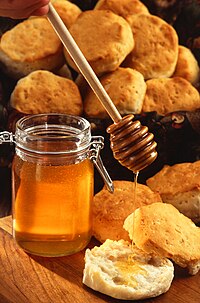
Photo from wikipedia
Five in vitro experiments were conducted with the following objectives: 1) To evaluate the ruminal fermentation of three different single ingredients: corn, glycerin, and starch (Exp. 1 and 2); 2)… Click to show full abstract
Five in vitro experiments were conducted with the following objectives: 1) To evaluate the ruminal fermentation of three different single ingredients: corn, glycerin, and starch (Exp. 1 and 2); 2) To assess effects of partially replacing corn with glycerin in beef cattle diets on ruminal fermentation pattern (Exp. 3 and 4); and 3) To evaluate the effects of glycerin inclusion on the extension of ruminal DM digestibility of feeds with high (orchard hay) and low (corn) fiber content (Exp. 5). For Exp. 1 and 2, two in vitro systems (24-bottle AnkomRF and 20-serum bottles) were used in four consecutive fermentation batches to evaluate gas production (GP), fermentation profiles, enteric methane (CH4), and carbon dioxide (CO2) of corn, glycerin, and starch. The 24 h total GP, acetate concentration, and acetate: propionate ratio decreased only when glycerin was added to the diet (P < 0.01). The 48-h total GP and metabolizable energy were greatest for corn (P < 0.01), and similar between glycerin and starch. The starch treatment had the lowest total volatile fatty acids concentration (P = 0.01). Glycerin had greatest CH4 production, lag time, and maximum gas volume of the first pool (P < 0.05). However, the maximum gas volume of the second pool was greatest for corn (P < 0.05), and similar between glycerin and starch. The starch treatment had the greatest specific rates of digestion for first and second pools (P < 0.05). Production of CO2 (mL/g) was greater for corn (P < 0.01), but similar for glycerin and starch. For Exp. 3 and 4, the same systems were used to evaluate four different levels of glycerin [0, 100, 200, and 300 g/kg of dry matter (DM)] replacing corn in beef cattle finishing diets. Glycerin levels did not affect 24 and 48 h total GP, CH4, and CO2 (P > 0.05). The inclusion of glycerin linearly decreased acetate concentration (P = 0.03) and acetate: propionate ratio (P = 0.04). For Exp. 5, two DaisyII incubators were used to evaluate the in vitro dry matter digestibility (IVDMD) of the following treatments: orchard hay; corn; orchard hay + glycerin; and corn + glycerin. Glycerin inclusion decreased orchard hay IVDMD (P < 0.01) but did not affect corn IVDMD (P > 0.05). We concluded that, under these experimental conditions, glycerin has similar energy efficiency when used in replacement of corn and included at up to 300 g/kg in beef cattle diets.
Journal Title: PLoS ONE
Year Published: 2018
Link to full text (if available)
Share on Social Media: Sign Up to like & get
recommendations!